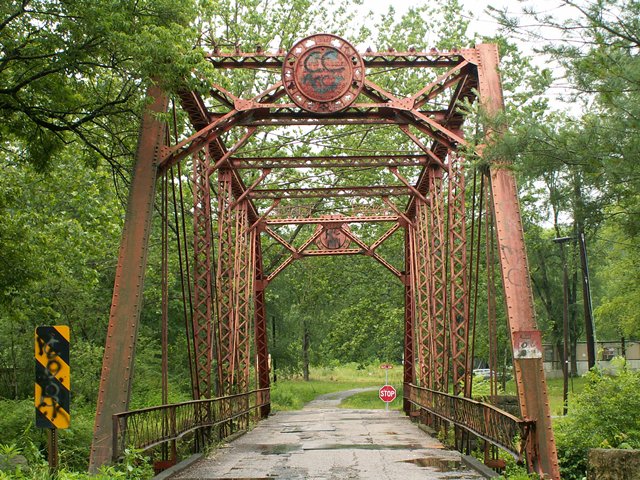We Recommend:
Bach Steel - Experts at historic truss bridge restoration.
BridgeHunter.com Phase 1 is released to the public! - Visit Now
Clarks Mill Road Bridge

Primary Photographer(s): Nathan Holth
Bridge Documented: July 4, 2006
Rural: Columbiana County, Ohio: United States
1912 By Builder/Contractor: Central Concrete and Construction Company of Canton, Ohio and Engineer/Design: B. M. French
Not Available or Not Applicable
88.0 Feet (26.8 Meters)
92.0 Feet (28 Meters)
13.8 Feet (4.21 Meters)
1 Main Span(s)
1536273

View Information About HSR Ratings
Bridge Documentation
This bridge no longer exists!
View Archived National Bridge Inventory Report - Has Additional Details and Evaluation
This historic bridge was demolished and replaced in 2007!
This bridge is a fairly short version of a number of Ohio through truss bridges with unique "medallion" plaques which are noted for their distinctive, large circular plaques on the portal, and often have other miscellaneous decorations present. These bridges with medallion plaques however are not the oldest of metal truss bridges, but they retain 19th century thinking including decorative portal cresting and pinned connections. The medallion plaque on this bridge lists commissioner information and en engineer, but a builder is not listed. Other surviving bridges that have these plaques and portal cresting design also have a second plaque on top of the portal bracing listing Central Concrete Construction Company of Canton, Ohio as the builder of the bridge. Others have identical plaques that list the Canton Bridge Company of Canton, Ohio. It is assumed then that one of these companies also built this bridge, and that this bridge likely also had a second plaque but that it was removed at some point.
This bridge is a six panel pin connected through truss. It features an a-frame portal bracing, with decorative portal cresting on top. The a-frame has some v-lacing on the steel that composes it. V-lacing is also present on the verticals and sway bracing, as well as under the top chord / end post. Original lattice railings remain on the bridge. The bridge is sitting on stone abutments. The deck is almost certainly original, as it is a rare jack-arch deck. So what is a jack arch deck? It is essentially taking what looks like halves of a steel corrugated culvert, and spanning the bottom of the deck stringers, and then pouring concrete on top, which mostly seals the deck stringers in, and creates a wearing surface. The problem with a jack-arch deck is over time the corrugated steel rusts out and falls away. Then, if the concrete starts to break up, it falls into the river too, and starts to create holes in the deck. Such is the case with the Clarks Mills Road Bridge, where the deck has required plate steel to be placed on the bridge in spots. Considering that the deck has remained the same without any other repairs since 1913, this really isn't that bad though. Decks are often the first thing to need repair on a truss bridge, besides routine painting.
Unfortunately, Columbiana County did not preserve this historic bridge like it has some of its other metal truss bridges. It is unclear why demolition was chosen for this bridge since it surely could have been rehabilitated like the other bridges in the county.
![]()
Photo Galleries and Videos: Clarks Mill Road Bridge
Bridge Photo-Documentation
Original / Full Size PhotosA collection of overview and detail photos. This gallery offers photos in the highest available resolution and file size in a touch-friendly popup viewer.
Alternatively, Browse Without Using Viewer
![]()
Bridge Photo-Documentation
Mobile Optimized PhotosA collection of overview and detail photos. This gallery features data-friendly, fast-loading photos in a touch-friendly popup viewer.
Alternatively, Browse Without Using Viewer
![]()
Maps and Links: Clarks Mill Road Bridge
This historic bridge has been demolished. This map is shown for reference purposes only.
Coordinates (Latitude, Longitude):
Search For Additional Bridge Listings:
Bridgehunter.com: View listed bridges within 0.5 miles (0.8 kilometers) of this bridge.
Bridgehunter.com: View listed bridges within 10 miles (16 kilometers) of this bridge.
Additional Maps:
Google Streetview (If Available)
GeoHack (Additional Links and Coordinates)
Apple Maps (Via DuckDuckGo Search)
Apple Maps (Apple devices only)
Android: Open Location In Your Map or GPS App
Flickr Gallery (Find Nearby Photos)
Wikimedia Commons (Find Nearby Photos)
Directions Via Sygic For Android
Directions Via Sygic For iOS and Android Dolphin Browser
USGS National Map (United States Only)
Historical USGS Topo Maps (United States Only)
Historic Aerials (United States Only)
CalTopo Maps (United States Only)

